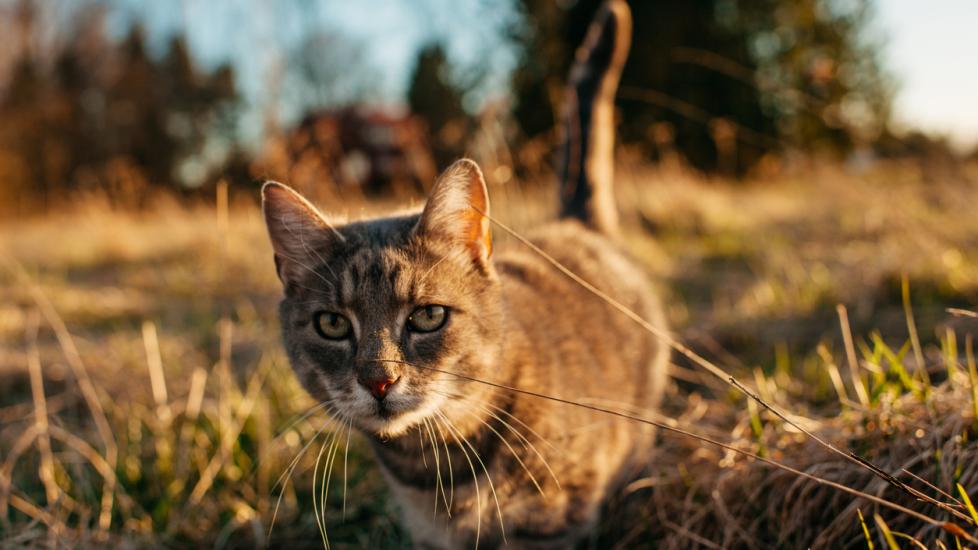Coccidioidomycosis in Cats
What Is Coccidioidomycosis in Cats?
Coccidioidomycosis, also known as valley fever, is a disease caused by the fungus Coccidioides immitis. Cats get infected with this disease after inhaling the spores from the air. It is transmitted to many species of animals, including cats and people, but dogs seem to be the most severely affected.
Since this infection enters the body by inhalation, it goes directly to the cat’s lungs, causing a local infection in the respiratory system. From the lungs, it can be absorbed into the bloodstream and travel to other parts of the body, which is called a disseminated infection. Disseminated infections are much more serious, but either form of coccidioidomycosis can be fatal in cats. Approximately 50% of infected cats appear to have disseminated disease.
This fungus is found in the soil predominantly in the U.S. Southwest, in a very dry region known as the Lower Sonoran life zone. It has also been reported in Northern Mexico, Central America, and South America in regions with the same arid and semi-arid climates. Recently it has been reported as far north as Washington State.
Vet Recommended Health Support
- Feliway Optimum Enhanced Calming 30 Day Diffuser for Cats$29.99Chewy Price
- Purina Pro Plan Veterinary Diets FortiFlora Powder Probiotic Digestive Supplement for Cats, 30 count$30.99Chewy Price
- Purina Pro Plan Veterinary Diets Hydra Care Liver Flavored Liquid Supplement for Cats, 3-oz pouch, case of 12$14.99Chewy Price
- Purina Pro Plan Adult Sensitive Skin & Stomach Lamb & Rice Formula Dry Cat Food, 7-lb bag$28.08Chewy Price
Symptoms of Coccidioidomycosis in Cats
Clinical signs tend to develop within a few weeks after spores are inhaled into the lungs. If the fungal spores escape the lungs and travel throughout the body, it can take several months after the initial cough for other signs to develop. Sometimes the initial cough can be mild, and infection can go undetected until the animal is very ill.
Other areas of the body commonly affected in cats with disseminated coccidioidomycosis are the skin, muscles, bones, brain, spinal cord, and eyes. It’s very important to have your cat examined by their veterinarian at the first sign of any illness or abnormality, even if it does not seem significant at the time. A cough in cats should always be taken seriously, as it can be an indication of a medical emergency.
-
Early signs:
-
Coughing
-
Lethargy
-
Fever
-
Lack of appetite
-
-
Severe cases, disseminated signs:
-
Skin issues such as non-healing, infected, draining tracts, masses, or abscesses
-
Joint pain, presenting as lameness/limping, weakness, trouble getting up and down
-
Back and neck pain
-
Seizures
-
Blindness
-
Causes of Coccidioidomycosis in Cats
As noted, coccidioidomycosis, or valley fever, occurs after cats inhale fungal spores. This illness can occur in a cat that has inhaled fewer than 10 microscopic fungal spores. Coccidioidomycosis is a dimorphic fungus, which means it can exist both as yeast (single cell) and mold (multicellular). This fungal organism grows deep in the soil and can survive at high temperatures and low moisture in desert regions.
During the rainy season, this fungus will return to the surface of the soil and produce spores, which are spread rapidly by wind. Cats are most often infected after the soil has been disturbed, such as after rainfall, a dust storm, an earthquake, a crop harvest, or during construction.
Most cats infected with valley fever are young, as these are the cats that tend to be most active outdoors. Cats that dig in the dirt or that live in areas where they are in or around dust storms may also be at greater risk for exposure. For cats living in areas where Valley Fever has been reported, keeping them indoors, especially during the rainy season or when major weather events occur, is highly recommended. Rapid spread of this fungal disease may occur when rainy periods are followed by drought, resulting in dust storms.
In general, valley fever is not contagious among cats, between cats and dogs, or between cats and people. However, in one case from 2008 in which a veterinary technician was bitten by a cat, the wound was diagnosed as coccidioidomycosis.
How Veterinarians Diagnose Coccidioidomycosis in Cats
An important aspect of diagnosing a valley fever infection is to know if your cat frequents the type of place that harbors the fungal organism, so providing your veterinarian with a detailed history of your pet’s activities is critical. A complete physical examination will also be performed, and full bloodwork (chemistry panel, complete blood count, and electrolyte panel) including urine testing is usually ordered to assess body function and to rule out other conditions that might cause similar signs.
Diagnosis of valley fever can be very difficult in cats and is usually made through visualization of fungal organisms under the microscope. However, coccidioidomycosis should be considered in cats with consistent clinical signs within the endemic region — a particular area where a disease outbreak is known to have occurred.
A special blood test called a titer is also important in making the diagnosis for valley fever. If your cat has lesions on the skin or other organs of the body, a biopsy may be needed to collect cells or remove a piece of abnormal tissue to test for the coccidioidomycosis-causing organism. These lesions can be found during physical examination as skin abscesses, on radiographs as lung nodules, or even using advanced imaging such as a CT scan or MRI for advanced lung disease or when other body systems are affected.
In cats that are coughing with or without lung disease evident on the initial chest x-rays, an airway wash (tracheal wash or tracheal lavage) is typically ordered. This procedure requires your cat to be heavily sedated so that lung fluid samples can be collected for analysis. It is possible that your vet can see the fungal spores in this analysis, which would confirm the diagnosis.
Treatment of Coccidioidomycosis in Cats
Most cats with coccidioidomycosis are treated at home rather than in the hospital. Treatment for cats with valley fever involves an extended course of oral antifungal medication, usually fluconazole. Hospitalization is highly dependent on how severely affected your cat is. Cats that are having breathing issues or are not eating are more likely to be hospitalized. Other supportive care may be necessary to help with symptoms, including oxygen therapy for those having trouble breathing, IV fluids, anti-inflammatories, appetite stimulants, or liver protectants.
Antifungal medications often have side effects on the liver and gastrointestinal system. For this reason, it is important that your vet monitor your cat’s liver enzymes and other body functions with bloodwork and urine testing done routinely during and after treatment.
Aggressive antifungal therapy is usually required from several months to over a year. The decision to stop antifungal medication will be determined after your cat’s clinical signs have resolved and after two blood tests are negative for active infection.
Recovery and Management of Coccidioidomycosis in Cats
If illness is limited to the lungs and treated with appropriate medication, the prognosis is good and the recovery rate approaches 90%. Unfortunately, the long-term prognosis for cats with disseminated coccidioidomycosis is guarded, as relapse of the disease is common following initial treatment.
Many cats will improve with oral antifungal medication. However, relapses are common, especially if therapy is not completed as prescribed or is shortened unnecessarily. Recovery without treatment is not typical, but it is possible for an animal to develop an immunity to the infection and recover from it. Asymptomatic infections may occur, in which cats are exposed but develop immunity without experiencing the signs of the full-blown disease.
Coccidioidomycosis in Cats FAQs
Is valley fever curable in cats?
Valley fever can be fatal if left untreated; however, once the disease is diagnosed, most cats will recover in time with consistent treatment and follow-up care with their veterinarian.
Where is coccidioidomycosis found?
The fungus causing valley fever is found in the soil, predominantly in the Lower Sonoran life zone in the U.S. Southwest and in Northern Mexico, Central America, and South America in regions with the same arid and semi-arid climates. It has, however, been reported as far north as Washington State.
Can coccidioidomycosis in cats be transferred to humans?
In general, valley fever is not contagious between cats and people. There is, however, one case in which a veterinary technician was infected after being bitten by cat with disseminated coccidioidomycosis.
Featured Image: iStock/knape




